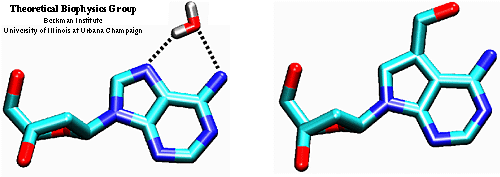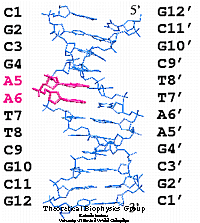|
|
|
|

|

|
| DNA hydration has been studied extensively,
both experimentally and theoretically. Computational studies on the hydration
of DNA showed conformation-dependent differences in both geometry and the
extent of hydration for the major and minor grooves. The role of water-mediated
hydrogen bonds in protein-DNA interactions and the potential contribution
to the thermodynamics of DNA-ligand binding indicates the need to know
the precise location of water molecules bound in the minor and major grooves
of DNA.
Nucleoside analogues offer an alternative means to explore the role
of water molecules in DNA and in protein--DNA interactions. J. Rockhill
[1] suggested that the analogue 2'-deoxy-7-hydroxymethyl-7-deazaadenosine
(hm7c7dA), might mimic a bound water molecule complexed to an adenine residue
in the major groove of DNA.
 |
Adenosine (left) and 2'-deoxy-7-hydroxymethyl-7-deazaadenosine
(hm7c7dA) (right). Coloring scheme for atoms: oxygen is red, carbon is
cyan, nitrogen is blue. |
The analogue (hm7c7dA) was modeled into the DNA dodecamer, substituting
the two adenine bases in one strand (A5 and A6) individually or jointly,
creating four distinct systems.
The simulations, when compared to those of the dodecamer itself, show
that incorporation of the analogue affects neither the overall DNA structure
nor its hydrogen bonding and stacking nteractions when a single individual
base is replaced by the analogue.
 |
Crystal structure of the DNA dodecamer
used in the simulation and numbering scheme for the DNA bases. The adenine
bases substituted individualy or jointly with the analogue are represented
in red.
Water molecules near the bases in the singly-substituted oligonucleotides
are similarly unaffected. Double substitutions lead to differences in all
the aforementioned parameters with respect to the reference sequence. |
| Water molecules within hydrogen bonding distance
(proton-acceptor distances < 2.5 A and angle donor-proton-acceptor > 120 to the acceptor/donor groups of the GAATTC bases were selected and are shown superimposed (for a better representation the oxygen atoms of the water molecules are shown
as vdW sphere with a reduced radius). The DNA atoms are in vdW representation. The analogue bases are shown in grey.(click on the pictures for bigger images) |
The results suggest that the analogue provides a good mimic of specific
"ordered" water molecules observed in contact with the DNA itself and in
protein-DNA complexes. |
 Dorina Kosztin
Dorina Kosztin
 Richard Gumport
Richard Gumport
Publications
|
|
|